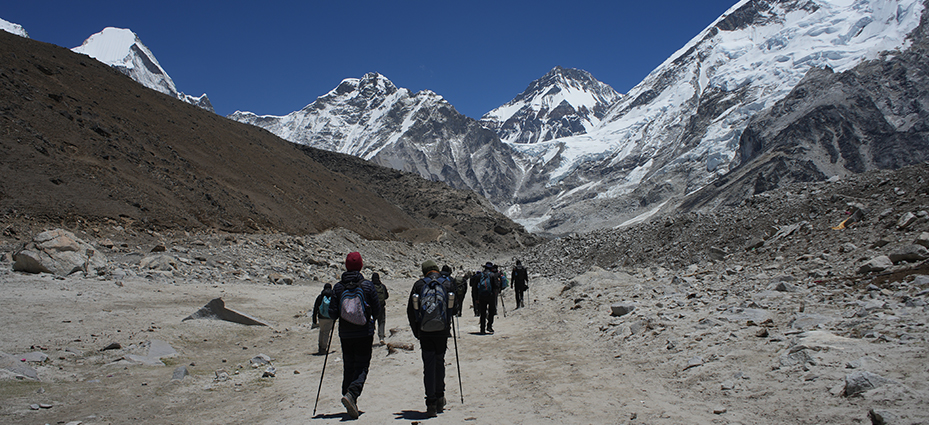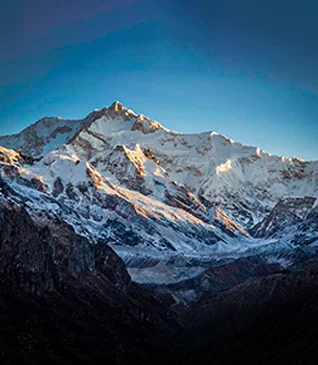For those who have a penchant for adventure and adrenaline, the Himalayas are a treasure trove of experiences. One such wonderful adventure in the Himalayan embrace is the Everest Base Camp Trek. It’s a journey that allures people from all over the world. While climbing Everest is not possible for every mountaineer or trekking enthusiast, Everest Base Camp can be attempted and accomplished by many. Standing at the base of the tallest mountain and witnessing the marvellous grandeur of nature from up close in itself is a big achievement.
Imagine standing at the foot of the world's tallest mountain, surrounded by a panorama that defies imagination, this is the Everest Base Camp Trek for you. With its rugged trails, stunning vistas, and the challenge of high altitudes, this trek is a gateway to personal discovery and an homage to the intrepid climbers who dared to conquer the world's mightiest peak.
Preparing For The Trek

Embarking on the Everest Base Camp Trek is a transformative experience that demands more than just a strong spirit of adventure – it requires careful preparation. The towering peaks, unpredictable weather, and challenging terrain demand a level of readiness that ensures both your safety and enjoyment throughout the journey.
Physical Fitness Is A Must

It's imperative to recognize that this trek demands a considerable level of physical fitness. The combination of high altitudes, steep ascents, and long hours of walking requires a body that's well-prepared for the endurance challenges ahead. Engaging in a well-rounded fitness routine that includes cardiovascular exercises, strength training, and hiking-specific workouts can significantly improve your trekking performance.
Equip Yourself Properly For The Journey Ahead
.webp)
Packing for the Everest Base Camp Trek is a delicate balance between essentials and avoiding unnecessary weight. Pack clothing suitable for layering, as temperatures can fluctuate dramatically. Essential gear includes sturdy trekking boots, a comfortable backpack, a warm sleeping bag, and trekking poles to ease the strain on your knees. Don't forget personal items like sunscreen, a first aid kit, and a refillable water bottle to stay hydrated.
These Tips May Come Handy
→ Acclimatization is the key. Acclimatization days are built into the trek for a reason – take them seriously. Listen to your body, hydrate, and don't rush the ascent.
→ Walk at a comfortable, sustainable pace, and avoid overexertion. This ensures you have the energy to enjoy the scenery and prevents altitude-related issues.
→ Don't skimp on quality when it comes to your trekking boots, as comfortable feet are essential. Also, invest in a good down jacket for warmth at higher altitudes.
→ Drink plenty of water to combat dehydration at high altitudes. Consume balanced, high-energy meals to fuel your trekking days.
→ The Everest region is home to a rich cultural heritage. Show respect for the local Sherpa communities and their traditions.
A Glimpse Into The Journey To The Everest Base Camp
.webp)
The trekking days are characterized by diverse landscapes, from verdant valleys to alpine meadows, rocky terrain, and glacial vistas. Along the way, you'll encounter suspension bridges, Sherpa villages, prayer flags, and serene monasteries that reflect the rich cultural tapestry of the region. Each day's trek is a step towards greater altitudes, offering ever-changing panoramas of towering peaks and awe-inspiring beauty. This journey isn't just about reaching the destination; it's about embracing the path and the stories it weaves along the way.
The Stunning Himalayan Landscapes
.webp)
The Everest Base Camp Trek unfolds as a visual symphony of nature's grandeur, where each step reveals a new stroke of beauty on an ever-changing canvas. The journey begins amidst verdant forests and soon, the terrain transforms into a rugged expanse of rocky trails, challenging every step and demanding a steadfast spirit. The air grows crisper, and the verdure gives way to arid landscapes. But with each ascent, the vistas expand, offering panoramic views that invigorates your determination.
And then, as you ventured further, the landscape undergoes yet another metamorphosis. The world around you becomes cloaked in a pristine white blanket of snow. The rugged terrain softens, and the peaks tower above, their icy summits gleaming like diamonds in the sunlight.
The Khumbu Icefall, the gateway to Everest, will humble you by its magnitude and beauty. Its frozen cascades resembles a colossal staircase, inviting both awe and reverence. The thought that brave climbers embark on this treacherous ascent to reach the world's highest peak is a reminder of the human spirit's relentless quest for the extraordinary.
Altitude Challenges & Acclimatization
The higher altitudes bring with them the risk of altitude sickness, a formidable challenge that can affect anyone, regardless of their fitness level. Understanding this risk and the importance of acclimatization is crucial for ensuring a safe and fulfilling trekking experience.
Altitude sickness, also known as acute mountain sickness (AMS), occurs when the body struggles to adapt to the reduced oxygen levels at higher elevations. Symptoms can range from mild headaches and nausea to more severe conditions like high-altitude pulmonary edema (HAPE) and high-altitude cerebral edema (HACE).
Acclimatization is the process of allowing your body to gradually adjust to the decreased oxygen levels at higher altitudes. It's your best defense against altitude sickness. Many Everest Base Camp trek itineraries include rest days to facilitate this adaptation. During these acclimatization days, your body has a chance to catch up and build more red blood cells to carry oxygen more efficiently.
Safeguard Your Journey
Amidst the excitement of exploring the Himalayas, it's crucial to prioritize safety and be prepared for any unforeseen circumstances. This is where having comprehensive travel insurance becomes not just a recommendation, but a fundamental aspect of your trekking preparation. The Everest region's challenging terrain and high altitudes come with a certain level of risk, including the potential for altitude sickness or unforeseen health issues. In these situations, travel insurance provides a safety net, offering coverage for medical emergencies, trip cancellations, delays, and more.
One of the most important aspects of having travel insurance for the Everest Base Camp Trek is the coverage it provides for helicopter rescue in case of emergencies. The rugged terrain, remote locations, and unpredictable weather conditions can make evacuation by helicopter the fastest and safest way to transport an individual requiring urgent medical attention to a suitable medical facility.
While we take every precaution to ensure the safety and well-being of our trekkers, having travel insurance provides an added layer of security. In the event that illness strikes or an accident occurs, travel insurance can cover medical expenses, including the substantial costs associated with helicopter rescue
Standing before the iconic Everest Base Camp is a culmination of efforts and dreams. It's a moment when you realize that what you have achieved is not just a trek; it's an embodiment of your determination, courage, and the indomitable human spirit. As you bask in the glow of this remarkable achievement, remember that the world is a treasure trove of natural wonders, waiting to be explored. It's a reminder that beyond the ordinary lies the extraordinary, and beyond comfort zones lies the realm of discovery.





.webp)










.webp)


